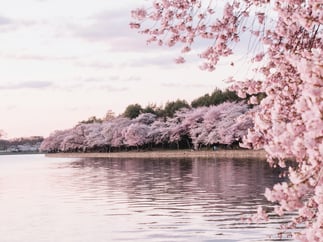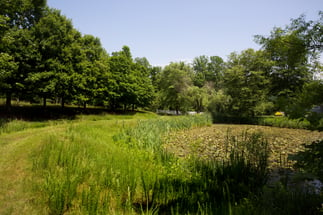Spring is in full bloom in the Washington, D.C. metropolitan area. The annual National Cherry Blossom Festival is underway, celebrating the gorgeous flowering trees dotting the landscape in our nation’s capital.
It’s impossible not to catch a whiff of the fresh new hope these fragrant beauties impart. To love the cherry trees is to appreciate not only them, but all trees’ importance to life on Earth.
A Brief History of the Cherry Trees
Hitting their blooming peak during the last week of March and the first week of April, the D.C. cherry trees were originally a gift from Japan. Under the administration of President William Howard Taft, whose wife Helen frequently traveled to Japan and was familiar with the special allure of “sakura” (cherry blossoms), 3,020 cherry trees from 12 varieties were shipped on February 12, 1912, from Yokohama to Seattle, then transferred via insulated freight cars to Washington, D.C.
On March 27, 1912, Mrs. Taft and the Viscountess Chinda, wife of the Japanese Ambassador, planted two cherry trees on the northern bank of the Tidal Basin (the site of the highest concentration of cherry trees in the District). This simple ceremony laid the roots for the first cherry blossom festival in 1935.
The rest is history, as they say, but more than 1.5 million visitors come to the D.C. region each spring to experience the splendor of the cherry blossoms.
Collington’s Accredited Arboretum
 Just a few short miles from the nation’s capital, Mitchellville, MD, is home to the vibrant Collington senior living community. In turn, Collington is home to a nationally accredited arboretum. Awarded Level One Accreditation by the ArbNet Arboretum Accreditation Program, the arboretum encompasses Collington’s 125 acres of wooded beauty, featuring over 100 different species and varieties of trees.
Just a few short miles from the nation’s capital, Mitchellville, MD, is home to the vibrant Collington senior living community. In turn, Collington is home to a nationally accredited arboretum. Awarded Level One Accreditation by the ArbNet Arboretum Accreditation Program, the arboretum encompasses Collington’s 125 acres of wooded beauty, featuring over 100 different species and varieties of trees.
Accreditation is the result of meeting ArbNet’s professional practice standards, including such factors as planning, governance, public access, programming and tree science. The Collington campus is also recognized by the Morton Register of Arboreta as an accredited arboretum.
Not ones to rest on our laurels (pun intended), the Collington community plans to label more of its trees, create additional walkways and add guided walks. One resident is working on a Google map of Collington Arboretum trees.
What residents, staff and visitors love most about the Collington grounds is the invaluable opportunity to explore the glory of nature right outside their doors. As such, another goal for the Collington Arboretum is to expand access to members of the greater Mitchellville community.
Why We Need Trees
There are an estimated 3 trillion trees on the planet, or about 400 per every person. Trees are not only lovely to look at (can you imagine a world without them?), they provide ample benefits to the ecosystem and most living and even manmade things.
- Better air quality. Trees reduce air pollution by absorbing small particles, pollutants and gases like carbon dioxide from automobiles and industrial areas. Just one mature tree absorbs between 120-240 pounds of harmful toxins.

- Improved water quality. Trees reduce storm water runoff and help anchor soil, lowering costs of manmade storm water management systems. Reducing runoff also limits topsoil erosion, silt and other pollutants washed into lakes, rivers and streams.
- Less noise pollution. Leaves, branches and twigs on trees absorb sound waves, dampening unwanted noise from several sources, including roads and highways. Studies have shown that large swaths of trees can reduce grating highway sound by half.
- Hospitable wildlife habitats. Trees are home to birds, forest animals, wildflowers and smaller trees and plants, providing shelter, food, protection, reproduction sites and more.
- Energy benefits. Trees counteract the “heat island” effect in urban areas with little vegetation. They also cut heating and cooling costs and reduce demands on power sources.
- Economic advantages. Property values are higher in areas with ample trees, as they enhance neighborhood appeal and attract more prospective home buyers. Based on the amount and density of tree cover, property values can rise as much as 30%.
- Overall health benefits. Trees engage all five senses in pleasant, mood-enhancing ways, boosting “happy hormones” in the brain such as serotonin and dopamine. Spending time among trees has also been found to lower blood pressure and quell the effects of stress hormones like cortisol and adrenaline.
Arboretums Do Their Part
Arboretums ensure that certain species of trees, especially endangered varieties, don’t become extinct. Seeds from existing trees in an arboretum can be used to grow more in a safe, protected area. What’s more, many arboretums (like Collington’s) are held to the standards of accrediting organizations, ensuring the proper care, conservation and propagation of precious trees.





